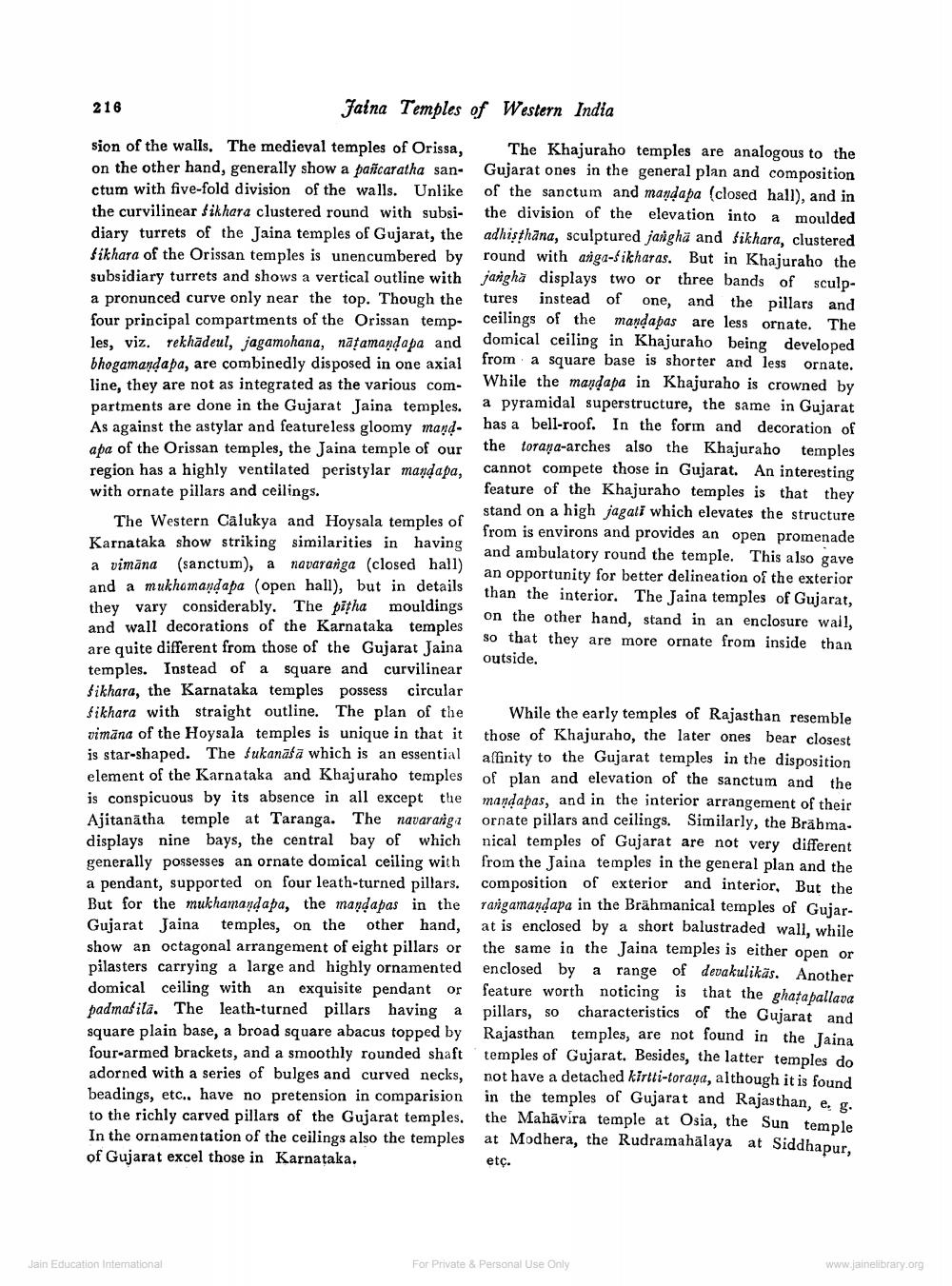________________
216
Faina Temples of Western India
sion of the walls. The medieval temples of Orissa, The Khajuraho temples are analogous to the on the other hand, generally show a pañcaratha san- Gujarat ones in the general plan and composition ctum with five-fold division of the walls. Unlike of the sanctum and mandapa (closed hall), and in the curvilinear Sikhara clustered round with subsi- the division of the elevation into a moulded diary turrets of the Jaina temples of Gujarat, the adhisthana, sculptured jangha and fikhara, clustered Sikhara of the Orissan temples is unencumbered by round with ariga-Sikharas. But in Khajuraho the subsidiary turrets and shows a vertical outline with jangha displays two or three bands of sculpa pronunced curve only near the top. Though the tures instead of one, and the pillars and four principal compartments of the Orissan temp- ceilings of the mandapas are less ornate. The les, viz. rekhadeul, jagamohana, natamandapa and domical ceiling in Khajuraho being developed bhogamandaba, are combinedly disposed in one axial from a square base is shorter and less ornate. line, they are not as integrated as the various com- While the mandapa in Khajuraho is crowned by partments are done in the Gujarat Jaina temples. a pyramidal superstructure, the same in Gujarat As against the astylar and featureless gloomy mand. has a bell-roof. In the form and decoration of apa of the Orissan temples, the Jaina temple of our the toraja-arches also the Khajuraho temples region has a highly ventilated peristylar maydapa, cannot compete those in Gujarat. An interesting with ornate pillars and ceilings.
feature of the Khajuraho temples is that they
stand on a high jagati which elevates the structure The Western Calukya and Hoysala temples of
from is environs and provides an open promenade Karnataka show striking similarities in having
and ambulatory round the temple. This also gave a vimāna (sanctum), a navaranga (closed hall)
an opportunity for better delineation of the exterior and a mukhamandapa (open hall), but in details
than the interior. The Jaina temples of Gujarat, they vary considerably. The pitha mouldings
on the other hand, stand in an enclosure wall, and wall decorations of the Karnataka temples
so that they are more ornate from inside than are quite different from those of the Gujarat Jaina
outside. temples. Instead of a square and curvilinear Sikhara, the Karnataka temples possess circular fikhara with straight outline. The plan of the While the early temples of Rajasthan resemble gimana of the Hoysala temples is unique in that it those of Khajuraho, the later ones bear closest is star-shaped. The $ukanāšā which is an essential affinity to the Gujarat temples in the disposition element of the Karnataka and Khajuraho temples of plan and elevation of the sanctum and the is conspicuous by its absence in all except the mandapas, and in the interior arrangement of their Ajitanātha temple at Taranga. The navarangı ornate pillars and ceilings. Similarly, the Brābmadisplays nine bays, the central bay of which nical temples of Gujarat are not very different generally possesses an ornate domical ceiling with from the Jaina temples in the general plan and the a pendant, supported on four leath-turned pillars. composition of exterior and interior. But the But for the mukhamaụdapa, the mandapas in the rangamandapa in the Brahmanical temples of GujarGujarat Jaina temples, on the other hand, at is enclosed by a short balustraded wall, while show an octagonal arrangement of eight pillars or the same in the Jaina temple is either open or pilasters carrying a large and highly ornamented enclosed by a range of devakulikäs. Another domical ceiling with an exquisite pendant or feature worth noticing is that the ghata ballava padmašila. The leath-turned pillars having a pillars, so characteristics of the Gujarat and square plain base, a broad square abacus topped by Rajasthan temples, are not found in the Taina four-armed brackets, and a smoothly rounded shaft temples of Gujarat. Besides, the latter temples do adorned with a series of bulges and curved necks, not have a detached kirtti-torana, although it is found beadings, etc., have no pretension in comparision in the temples of Gujarat and Rajasthan, e.. to the richly carved pillars of the Gujarat temples. the Mahävira temple at Osia, the Sun temple In the ornamentation of the ceilings also the temples at Modhera, the Rudramahālaya at Siddhapur. of Gujarat excel those in Karnataka.
etc.
Jain Education International
For Private & Personal Use Only
www.jainelibrary.org




